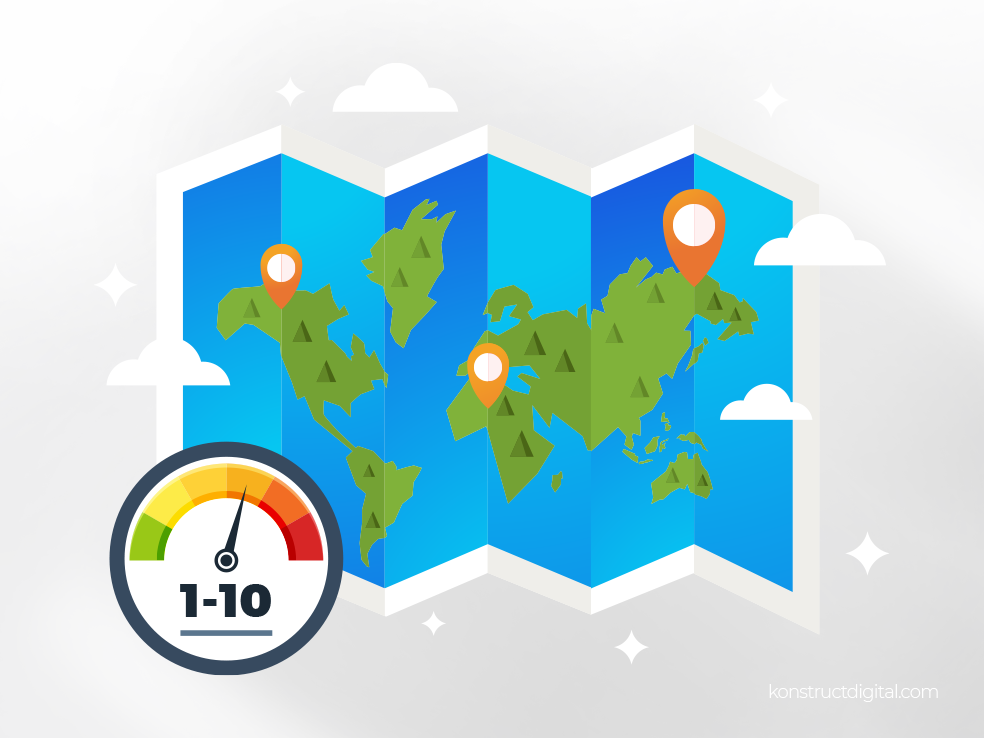Are you trying to gain more traffic to your website? Looking to show up on the first page of Google’s SERP but struggling to invest the time and effort into completing keyword research?
In this article, we will go step by step through the keyword research process, the importance of it, and how it can be the foundation of getting you on the first page of the SERP. We will also ensure you have the necessary information and tools you need to reach your potential customers and your SEO goals.
Pro tip: Be on the lookout for our pro tips! We’re going to share some specific tips and information throughout this article that will make the keyword research process a lot easier for you.
What is Keyword Research?
Keyword research for SEO is the process of researching and finding relevant terms or phrases that your target audience enters into search engines, like Google or Bing. The point of keyword research is to find keywords with the best possible opportunity for your pages to rank and generate as much organic traffic as possible.
Why Is Keyword Research Important?
Keyword research is the number one way to really understand your audience and their search behaviours. It’s important to do keyword research so that when you create your content for your site, you use terms that people are actively searching for. When you write your content, think of yourself as having all of the answers, and your keywords are guiding your target audience to find them.
How To Do Keyword Research for Search Engine Optimization

We’re breaking keyword research into 9 steps that will help you gain insights on what your target audience is searching for, so you can set yourself up for success to gain more relevant traffic to your site.
1. Set Your Goals With a Spreadsheet
Getting started with keyword research may seem like a puzzle at first, but it is a systematic process that will help you find keywords that have great opportunities for your business.
Start by creating a spreadsheet with sections for keyword options and keyword characteristics; this includes competition, average monthly search volume, keyword intent and keyword difficulty. Once you have completed your initial keyword research, this data will be instrumental in choosing a primary keyword. Your primary keyword will guide you through your campaigns and help you target your SEO goals.
2. Begin Your Keyword Research With The Best Keyword Research Tools

Now that you have your key topics, it’s time to take them and begin your keyword research process!
You might be thinking “I don’t even know where to start!”. Don’t worry! First, we will dive into 4 SEO tools that will help you begin your journey to finding relevant keywords that best relate to your business.
Google Keyword Planner
As one of the best free keyword research tools, the Google Keyword Planner will help you find new keywords, get suggestions for other relevant keywords and show you characteristics of these keywords, including the average monthly search volume, competition and more. When you fill out your spreadsheet for your initial keyword research, you will use this tool.
Ahref Keyword Explorer
Ahref Keyword Explorer is a great keyword research tool that helps determine how hard it is to rank in your keyword’s top 10 search results. Once you enter your keyword, you can discover the keyword difficulty score, the average monthly number of clicks and discover even more unique keywords. You will also use this tool in your initial keyword research to help you discover more keyword opportunities.
Unlike Google Keyword Planner, Ahref Keyword Explorer will allow you to access data from multiple search engines. Instead of using insights provided by Google search, you can analyze keywords from Google, Bing, Youtube etc.
SEMRush Keyword Magic
This tool can provide you with over a million keyword suggestions with all of their competition scores, monthly average search volume and more. Regardless of if your topics are niche or broad, SEMRush is a great tool to determine keywords that will help you reach your SEO goals. When you complete your keyword research, you will also use this tool to find additional keywords.
3. Identify Relevant Topics
Identifying and discovering keywords related to your industry is the first step to your keyword research. To do this successfully, you must know the ins and outs of your business, so you know which keywords and queries result in high-value traffic.
Once you have made a spreadsheet to store your information and know which tools to use, make a list of topics relevant to your business, product or service. For example, if you are an electrical company, your topics may include commercial electrician, residential electrician and other services that you offer.
Pro tip: If you are struggling to gain ideas of possible topics that you can use to start your research process, take a look at your landing page. If you sell products, what type of products? Try and be as specific as you can while still targeting some broader elements.
4. Identify Your Geographic Targeting Area
Before you can dive into finding keywords you need to know the geographic area that you are targeting. Google search results vary depending on where you are located, so it’s important to target these specific locations.
Suppose you are an electrical company offering services in Calgary. You don’t want to target searchers in other cities as your site will not be relevant to people living in Vancouver or Toronto as you don’t offer services in these locations! Identifying your geographical area is vital to determine the monthly average search volume based on local searches.
Pro Tip: Google Keyword Planner will allow you to find the keywords average monthly search volume for a specific province, state, city or territory, whereas the rest of the tools only allow you to find this information based on a Country. We recommend that you use the Google Keyword Planner when you are finding the average monthly search volumes of your keywords.
5. Beginning the Initial Keyword Research Process

To make sure you’re still with us, ensure you have identified the topics you need to cover based on your goals and have inserted the proper geographic area based on your target audience in the geographic targeting section of the Keyword Planner.
Start by adding your topics into the Google Keyword Planner to find general keywords that may potentially help you reach your goals. Once you have inserted your topics, you will see characteristics that compliment your keywords, which will help you determine which keywords will provide you with the best opportunities. The following are key characteristics you are looking for and what they mean.
Average Monthly Search Volume
The average monthly search volume is the average number of times your keyword is entered into search engines per month.
You want to input these volumes into your spreadsheet to compare your keywords and choose a keyword with the highest relative search volume. Keep in mind that there are more characteristics to cross-reference, so don’t just pick a keyword based on this aspect.
Competition
The competition metric in the Google keyword planner shows how competitive the keyword is from a Google Ads perspective. If the competition is high, there is a lot of bidding on this keyword in Google ads; if the competition is low or N/A, it means there is little to no bidding on this keyword. This metric allows us to see how important this keyword is to competitors interested in the same keyword.
Place your keyword difficulty in your spreadsheet so that you can compare these keywords and choose one with low competition. This may not always be possible, which is okay! Even if a keyword has high competition, it still might provide you with the best opportunity.
Year-Over-Year Change
Another important key characteristic of keyword research is identifying your year-over-year change. These keyword metrics compare the average search volume of the last month with the same month from the year prior. This will give you a great indication of how the popularity of your keyword changes over time.
Now that you better understand these key elements, you want to find these characteristics and place them in your spreadsheet. After completing this step, you should now have a spreadsheet of your overarching topics with relevant initial keywords and their corresponding characteristics.
6. Identify Keyword Intent
Before you can identify your primary and secondary keywords, we still need to find out some more information, like keyword intent, so we can choose a keyword that will provide you with the best opportunities.
Keyword intent, sometimes known as search intent, is fundamental. Keyword intent represents the purpose of a user’s search. You have to choose the right keyword with the right intent for your search, or you will research a keyword that doesn’t align with your goals. Keyword Intent can be broken down into 4 categories:
- Top-of-Funnel – Top-of-funnel is problem awareness searches. These are often searches that include terms related to the client’s industry or general offering.
- Middle-of-Funnel – Middle-of-funnel is solution awareness searches. These are often searches that include terms directly related to the client’s specific services or products.
- Bottom-of-Funnel – Bottom-of-funnel are searches that are conversion-focused; these searches often include terms such as “purchase” or “contact”.
- Branded – Branded searches are searches related directly to the client’s brand.
By analyzing the keyword and cross-referencing the categories of keyword intent, you will find one that you feel best defines the search.
7. Discover The Keyword Difficulty Percentage for Each Geographic Area

Final steps…you’ve almost successfully completed your initial keyword research!
Your spreadsheet should now include potential keywords, characteristics, and keyword intent. Before analyzing these elements, you need to check the keyword difficulty scores for your geographic area. This will ensure that you have checked all of your boxes and are confident that you discovered potential keywords that are relevant to what your target audience is searching.
For this step, we recommend using the SEMRush Keyword Overview Tool. Plug your keywords into the “Keyword Overview” section in the tool; ensure you set the correct country you are targeting. Once you have completed this, you will find your percentage, which you can add to your spreadsheet.
Keep in mind that if your keyword does not have a high enough search volume, SEMRush Keyword Overview Tool may not provide a keyword difficulty percentage.
8. Identify Primary and Secondary Keywords
You have successfully completed your initial keyword research, and you’re ready to identify your primary and secondary keywords!
The absolute most crucial thing when mapping a keyword or deciding primary and secondary keywords is that the keyword intent matches the intent of the landing page. Ensuring relevancy is super important, or you will generate traffic that bounces or finds your content useless. If users don’t interact with your content, it will plummet your search rankings. So, you absolutely need to make sure you are mapping keywords to pages with content that will satisfy the user’s search query.
Once you have determined which keywords are relevant to your landing page, you will need to go through each keyword on your spreadsheet and cross-reference their characteristics. For reference, you are aiming to choose a keyword with:
- High average search volume
- Low competition
- Low keyword difficulty percentage
- Relevant keyword intent
- Relevant year-over-year change to ensure your content still gains traffic
To start, analyze the average search volume and competition of your keyword. For example, you want a keyword with high search volume but low competition. If one of your keywords’ search volume was 100 with low competition, and your other keyword had a search volume of 150 with high competition, you would choose the low competition and high search volume. In this case, your primary keyword may be the one with a search volume of 100 and low competition.
Based on these aspects, choose a primary keyword that will provide you with the best opportunity to gain more organic traffic. Once you have your primary keyword, you can evaluate your other potential keywords and choose additional secondary keywords that will also help you reach your goals. Think of it like a sports team; you have your primary keyword—your captain–and your supporting teammates–your secondary keywords. They will work together to help provide you with the best results for your SEO goals, with you as a coach placing these keywords in relevant areas on your site.
9. Reach Your SEO Goals
You did it! We’re so excited that you have properly completed your keyword research and found some tools that will help you on the path to increasing your organic traffic. Check out our SEO blog page if you’re ready for the next step or are interested in learning more of our secret SEO tricks and tips from our SEO specialists.
Bonus Keyword Research Tips

You’ve found your keywords, but we think some extra tips will be beneficial for you to know throughout the process!
Relevancy, Relevancy, Relevancy
Relevancy is extremely important. Remember how we talked about making relevant topics that relate to your content or site to begin your keyword research? We’re including it twice because it’s that important!
If you choose a keyword that has no relevance to your page, your visitors are unlikely to stay on your page–or even visit your site in the first place! Google tracks your page, and when they see users exiting your site quickly, it can increase your site’s bounce rate and negatively impact your SEO.
Don’t skip taking that extra time to ensure your keywords are relevant!
Evaluate Your Competition
If you want to come out on top, and you should, it’s essential to do competitor keyword analysis. This is a “reverse-engineering” process of your competitor’s website. You can determine what keyword phrase they are ranking for and see how those keywords compare to you and your site. Evaluating your competition can help you find even better keywords and help you beat your competitors.
Use Localized Keywords When Applicable
Localized keyword research will help you understand what people are searching for when looking for local businesses’ products or services. These keywords contain location-specific words or phrases that will create results relevant to the geographical location of your business. It will help drive people to your site and plays a significant role in optimizing your local SEO strategy.
Level Up Your SEO Strategy With Konstruct Digital

Now that you have gone through the keyword research process, you should have a primary keyword and a handful of relevant secondary keywords that are targeted to your desired audience and will give your page the best chance of driving the most relevant organic traffic to your site.
How do you feel after completing this process? Keyword research is meticulous and can be tricky. Expert assistance is another great tool that can help you streamline your keyword research process.
If you’re looking for help with your keyword research, or overall SEO strategy, reach out to Konstruct Digital! At Konstruct, we have SEO specialists who know and understand the ins and outs of search engine optimization. As industry experts, we are constantly staying up to date on all of the new SEO trends, updates, and strategies!
Contact us today, and let’s work together to grow your organic traffic!








